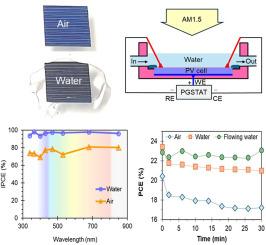水驱动光伏:通过活性层中的水介质提高性能
IF 7.9
3区 材料科学
Q1 GREEN & SUSTAINABLE SCIENCE & TECHNOLOGY
引用次数: 0
摘要
旨在减轻光学和热损耗的复杂设计策略导致了光伏(PV)技术的重大改进。然而,这些策略通常需要增加处理时间、设备复杂性和系统成本。为了解决这些限制,本研究提出了一种简单的硅太阳能电池浸水策略。水层具有低折射率,直接与太阳能电池接触,降低了菲涅耳反射率,增强了光捕获,从而改善了二极管和光伏特性。在标准AM1.5照度下,商用光伏电池在空气、稳定水中和流动水中的功率转换效率分别为20.41%、23.42%和22.87%。在最佳水深条件下,电池在流动水中的现场发电量显著增强且保持稳定,变化幅度在1%以下。浸没法还提高了器件在不同光照明波长和强度下的性能,在850 nm处保持较高的PCE。太阳能电池在流水中的温度保持在17℃,保证了现场电力的高可靠性。这种简单而经济的方法是一种有前途的高性能和可靠的太阳能发电策略,可能对可再生能源的广泛部署做出重大贡献。本文章由计算机程序翻译,如有差异,请以英文原文为准。

Water-driven photovoltaics: Enhancing performance through water media in the active layer
Complex design strategies aimed at mitigating optical and thermal losses have resulted in significant improvements in the photovoltaic (PV) technology. However, these strategies often entail increased processing time, device complexity, and system cost. To address these limitations, a simple water-immersion strategy for silicon solar cells is proposed in this study. The water layer, with a low refractive index and in direct contact with the solar cell, reduces Fresnel reflectance and enhances light trapping, leading to improved diode and photovoltaic characteristics. Under standard AM1.5 illumination, the commercial PV cells in air, steady water, and flowing water show power conversion efficiencies (PCEs) of 20.41 %, 23.42 %, and 22.87 %, respectively. With the optimal water depth, the cell in flowing water shows significantly enhanced and consistent onsite power generation, with the variation below 1 %. The immersion method also improves device performance across various light illumination wavelengths and intensities, maintaining a high PCE at 850 nm. The temperature of the solar cell in flowing water remained at 17 °C, ensuring high and reliable onsite power. This simple and cost-effective method presents as a promising high-performance and reliable strategy for solar power generation and may contribute significantly to the widespread deployment of renewable energy.
求助全文
通过发布文献求助,成功后即可免费获取论文全文。
去求助
来源期刊

Materials Today Sustainability
Multiple-
CiteScore
5.80
自引率
6.40%
发文量
174
审稿时长
32 days
期刊介绍:
Materials Today Sustainability is a multi-disciplinary journal covering all aspects of sustainability through materials science.
With a rapidly increasing population with growing demands, materials science has emerged as a critical discipline toward protecting of the environment and ensuring the long term survival of future generations.
 求助内容:
求助内容: 应助结果提醒方式:
应助结果提醒方式:


